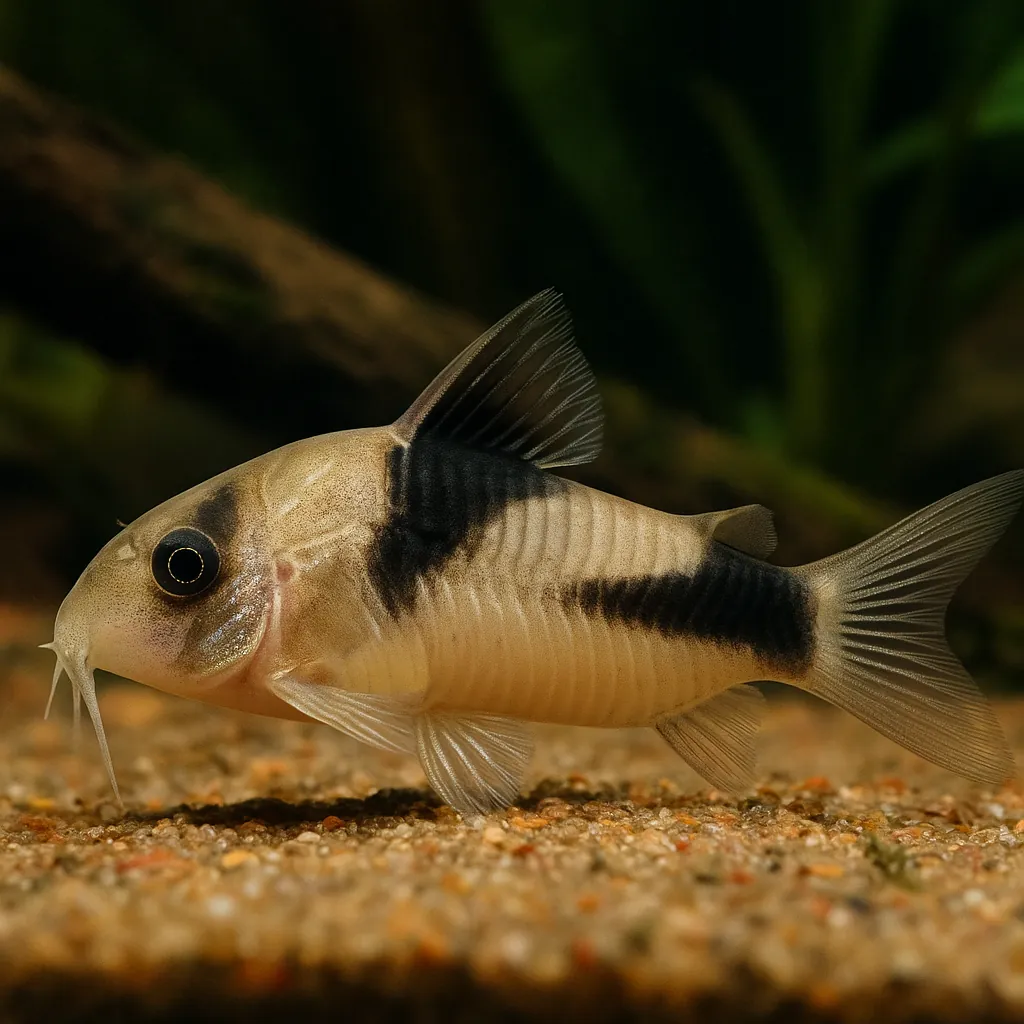
Skunk cory
Introduction
The Skunk Cory (Corydoras arcuatus), also known as the Arched Corydoras, is a popular freshwater fish among aquarists due to its distinctive appearance and peaceful nature. Characterized by a bold black stripe that arches from its snout to the tail, resembling a skunk's pattern, this bottom-dwelling species adds both visual interest and functionality to community aquariums. Skunk Corys are relatively easy to care for, making them suitable for both beginner and intermediate fishkeepers.
Care and Environment
Providing optimal care for Skunk Corys involves attention to tank size, water parameters, substrate, and diet.
What is the minimum tank size for a Skunk Cory?
A minimum tank size of 60 litres is recommended to accommodate a small group of Skunk Corys, as they thrive in social settings.
What are the ideal water parameters for Skunk Corys?
Maintain a temperature range of 22°C to 26°C, a pH between 6.0 and 7.5, and water hardness from 2 to 15 dGH to replicate their natural habitat conditions.
What type of substrate is best for Skunk Corys?
A soft, sandy substrate is ideal to prevent damage to their sensitive barbels, which they use to forage along the tank bottom.
Incorporate live plants, driftwood, and smooth rocks to provide hiding spots and mimic their natural environment. Ensure the tank is well-filtered with gentle water flow and moderate lighting. As omnivores, Skunk Corys should be fed a varied diet, including high-quality sinking pellets, live or frozen foods like bloodworms and brine shrimp, and occasional blanched vegetables such as zucchini or spinach. Feed them once or twice daily, ensuring food reaches the bottom where they can access it.
Origin and Habitat
Skunk Corys are native to the upper Amazon River basin, specifically in countries like Brazil, Colombia, Ecuador, and Peru. They inhabit fast-flowing tributaries with clear, well-oxygenated waters. These environments typically feature sandy or fine gravel substrates and are often densely vegetated, providing ample hiding spots and foraging grounds. Seasonal variations, such as the rainy season, can lead to changes in water flow and habitat conditions, influencing their natural behaviors.
Temperament and Compatibility
Skunk Corys are peaceful, social fish that thrive in groups of at least five individuals. They exhibit shoaling behavior, which enhances their sense of security and natural activity levels.
Are Skunk Corys suitable for community tanks?
Yes, their gentle nature makes them excellent candidates for community aquariums.
What are ideal tank mates for Skunk Corys?
Compatible tank mates include small, non-aggressive species such as tetras, rasboras, guppies, and other peaceful bottom dwellers like loaches.
Are there any fish species to avoid housing with Skunk Corys?
Avoid pairing them with large or aggressive fish that might harass or outcompete them for food.
Providing ample hiding spots and maintaining a harmonious tank environment will help ensure the well-being of Skunk Corys and their tank mates.
Interesting Facts
Skunk Corys possess several intriguing traits that endear them to aquarists.
How do Skunk Corys contribute to tank cleanliness?
As diligent scavengers, they help maintain tank cleanliness by foraging for leftover food and detritus along the substrate.
What is unique about their breeding behavior?
During breeding, females carry fertilized eggs between their pelvic fins before depositing them on surfaces like plant leaves or tank glass.
How long can Skunk Corys live in captivity?
With proper care, they can live up to 8 years, providing long-term enjoyment for aquarists.
These characteristics, along with their distinctive appearance, make Skunk Corys a delightful addition to freshwater aquariums.
Sources
All information in this article has been gathered from the following reputable sources:
Overview
Recommended Tank Size 26.4 Gallons (for groups of 6 or more) |
Minimum Group Size 5 |
Minimum Tank Volume 15.9 Gallons |
Maximum Adult Length 2.4 inches |
Average Adult Length 2 inches |
Shoaling (6+ required) Yes |
Preferred Water Type Freshwater, soft to slightly acidic |
Temperature Range (°C) 22–26 |
pH Range 6.0–7.5 |
Water Hardness (dGH) 2–15 |
Typical Lifespan (years) 5 years |